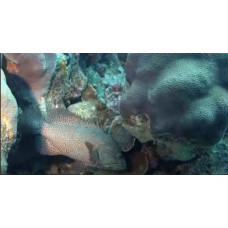Latin name
Cephalopholis cruentata
Other names
Spanish: enjambre, cherna enjambre, cuna cabrilla.
Identification
Graysby's colors range from pale gray to dark brown, with many dark oranges, red-brown spots on the body, fins, and chin. Along the base of the dorsal fin are three to five distinctive marks that look like pale or dark spots. Between the eyes from the back of the head to the lower lip is a white line. The spots change color, becoming either paler or darker in contrast to the body. The tail is more rounded than in similar species. The soft dorsal fin has 9 spines and 14 rays, compared to 15-17 rays in the closely related Сoney.
Distribution
Graysby live from North Carolina to the northern Gulf of Mexico, south to Brazil. Distributed in southern Florida, the Bahamas, the Caribbean, and also found in Bermuda.
Habitat
Small ledges and caves in coral beds and reefs are the preferred haunts of graysby, where they blend with the surroundings at depths between 10 and 60 feet.
Size
Graysby's usually grow to a length of 6 to 10 inches and can reach a maximum of 1 foot.
Life history and Behavior
No information
Food and feeding habits
Graysby are nocturnal predators, feeding mainly on fish.
Reproduction
No information
| Classification | |
| Phylum | Chordata |
| Class | Actinopterygii |
| Squad | Perciformes |
| Family | Serranidae |
| Genus | Cephalopholis |
| Species | C. cruentata |
| Features | |
| Conservation status | Least Concern |
| Habitat | Pelagic |
| Life span, years | 13 |
| Maximum body weight, kg | 1.1 |
| Maximum length, cm | 42.6 |
| Sailing speed, m/s | No information |
| Threat to people | Edible |
| Way of eating | Predator |
Graysby
Tags: Graysby



